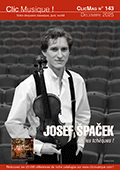 Au moment où le monde musical pleure la disparition d’Alfred Brendel, il est réconfortant de constater que de talentueux artistes comme Schaghajegh Nosrati continuent à explorer et à questionner ce répertoire viennois d’une richesse inépuisable. Le nouveau disque de la pianiste allemande (d’origine iranienne) consacré à Haydn en est un parfait exemple, où elle montre toute la variété et la spiritualité du Maître viennois. Si l’on retrouve ici les plus célèbres chefs-d’œuvre pianistiques de Haydn (comme sa dernière sonate, sa Fantaisie pour piano ou l’Andante et variations), Schaghajegh Nosrati intègre à son programme la savoureuse sonate Hob.XVI:26 nettement moins courue, mais tout aussi pétillante et ludique. Schaghajegh Nosrati interprète ces œuvres vivifiantes avec beaucoup d’élégance et de raffinement, n’hésitant pas à intégrer quelques ornementations personnelles particulièrement bienvenues et tout à fait dans l’esprit viennois. Malgré une prise un peu terne, son jeu lumineux et son élégance stylistique font merveille (sonate en mi mineur). La technique impressionnante de cette spécialiste de Bach lui permet d’interpréter idéalement ces musiques qui demandent de l’esprit et du bon goût, ce dont Schaghajegh Nosrati n’est nullement dépourvue. (Jean-Noël Regnier)  Those were the terms in which Wolfgang Amadeus Mozart praised his older colleague Joseph Haydn, with whom he remained close friends until the end of his life. It would be hard to find a better description of this music. Humour was an essential part of Haydn's musical language, but also of his character – at least if we are to believe the account of his contemporary Albert Christoph Dies, whose biography is based on conversations with the (already very elderly) composer: “Haydn explained that this was ‘a character trait of his that once came from an abundance of health... One is seized by a certain humour that cannot be tamed.’ ” However, reading this oldest biography of Haydn also gives us an idea that behind the cheerful, almost naïve façade lies a complex personality with a strong tendency towards melancholy and depression. Like every great composer, Haydn also looked into the abyss, especially in the later years of his life, when he suffered from increasing physical infirmity. The selection on this CD is a cross-section of the composer's successive creative phases. Haydn composed keyboard music over about four decades (ca. 1755-1796). In his day, the word “Clavier” was used as a generic term for various keyboard instruments that coexisted, namely the harpsichord, the clavichord, and the fortepiano (Hammerflügel). Depending on availability and purpose, either instrument was used. The clavichord was considered the best instrument for students to learn to play with nuances, and Haydn composed mainly on the clavichord. ....... Although on this recording I have decided to record all works on a modern grand piano, I found it important to take into account which instruments these pieces were intended for when deciding on matters of interpretation and performance. (aus dem Booklettext von Schaghajegh Nosrati)
 |
